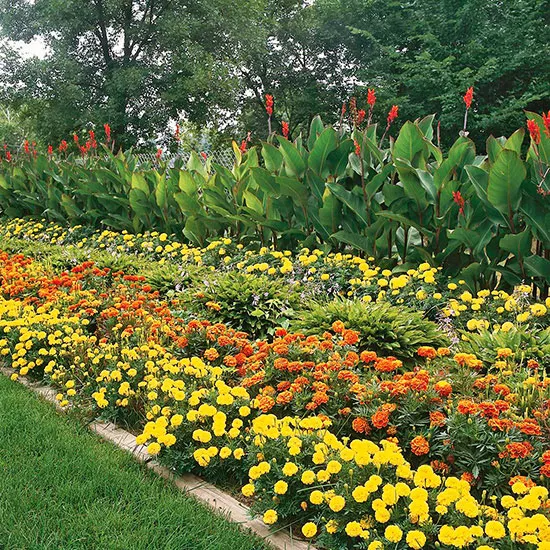Get a balanced look in your garden by arranging your plants by height. The simplest approach is to follow a short-to-tall format, with ground-hugging plants tucked along the edges of the beds and taller plants anchored to the back of the border. This tried-and-true method works wonderfully in beds with a distinct front and back. For containers or island beds viewed from all sides, tweak the technique by placing the tallest plants in the center. Then stair-step the plants outward, placing the shortest ones along the pot or bed edges.
When selecting plants, keep them in scale with their surroundings. For instance, if a bed skirts a 4-foot-tall fence, add plants that will reach a little above the fenceposts. If you select plants that are nowhere near the height of the fence, the structure will seem more prominent and may even appear to cage in the plants.
Once you've selected the tallest plant, stair-step the rest of the heights downward. A general rule is to step the heights down by half. So underplant a 6-foot-tall 'Pretoria' canna with a 3-foot-tall orange-flowering zinnia. Purple-toned ageratum or a Gomphrena that tops out at 18 inches strikes a pretty pose next to the zinnia. To supersize the planting, place an even taller castor bean or sunflower behind the cannas. If you don't have a structure to influence your plant selection, select the tallest plant to be equal to half the width of the planting area.
When choosing plants to surround a birdbath or sculpture, pick plants no more than two-thirds the height of the object they'll surround. When you purchase plants at a garden center, try to find large specimens to stage side-by-side comparisons. You can still purchase smaller plants to save money, but you'll be able to see their scale in relationship to one another. If you goof on scale and pair a tall banana with a creeping verbena, the look may be more cartoonish than attractive. Luckily, it's easily remedied. You can always pull and replant, or add midsize plants between the two. Less-forgiving scale mistakes occur when choosing an arbor or sculpture. If you err on the too-big side, you'll have to live with an object that looks like it escaped from a giant's garden, and it will overshadow your plantings. If you select an item that's too small, the other plants will overwhelm it, and it will be hard to see.
Trailers as Groundcovers
When you need to cover ground, consider trailing plants. While they look great cascading out of a container, they apply
that same growth habit
to create a colorful carpet in planting beds. Good choices include spreading petunia (such as Wave), Bidens, creeping zinnia, and purple heart.
Size It Up
While size is relative, in general you can count on these quick-color annuals and tender perennials to fill holes in a planting design for tall, medium, and short plants.
Tall (48-72 inches)
- Angel's trumpet
- 'Mahogany Splendor' hibiscus
- Sunflower
- Castor bean
- Ornamental millet
Medium (18-48 inches)
- Cleome
- Coleus
- Magilla Perilla
- Blue anise sage
- Zinnia
Short (4-18 inches)
- Impatiens
- Petunia
- Vinca
- Ageratum
- Creeping zinnia




















